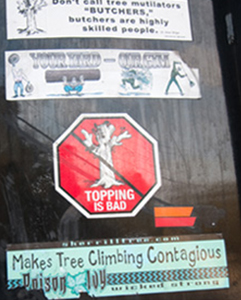It may be necessary to stake some trees in less-than-perfect conditions, however, it can have adverse effects on the long-term health of the tree. Staking a tree may actually cause it to develop a weak, or loose root system. Unstaked trees, however, respond to environmental stressors by spreading their roots farther and deeper than those that have other support. Also, the stakes and wires or strings themselves may cause damage to a tree’s trunk or branches that can compromise the health of the tree. If it is necessary to stake a new tree due to sloping soil or harsh wind, the materials should be removed within the first year to avoid harming the tree.
The truth is that tree wraps actually make the temperature changes worse and can hold moisture causing rot. Additionally, insects like to burrow beneath the wrap, so it does not provide any insect resistance.
Trees need their leaves to create food. Heavy pruning on any tree is not recommended. The tree will be better able to establish itself if it has a full crown. Limit pruning to structural training and removal of dead or damaged branches.
Trees don’t heal the way human bodies do. Instead of replacing the same tissue that was cut, trees produce special tissue to heal the cut. To facilitate this tissue production, cuts should be made above the “branch collar”. This is the most active part of the branch and allows the tree to heal without being compromised by rot.
Research has shown that many commonly used pruning dressings like spray actually slow the natural healing process of the trees. Instead, proper cut placement is the best way to keep your trees healthy after pruning and prevent further damage.
Topping trees is extremely damaging! While it may remove some potential hazards, it also creates weak, flimsy branches. Additionally, topping removes much needed leaves which the tree needs to absorb light and nutrients. The proper alternative to topping is professional trimming and pruning which removes dead, diseased, or unbalanced branches. Professional arborists like those at Sustainable Tree Care, are best equipped to make your trees safer and healthier with pruning.
While there may be some truth to the overall bulk of the root system being similar to the branches, the roots of a tree are shaped by the surrounding soil. Roots that encounter barriers will change direction and grow in the path of least resistance. Because of subsoil changes, most roots of a tree are located within three feet of the surface. The spread of the roots may actually be 2-3 times the spread of the branches.
Research does not support this common practice. In general, a tree with any kind of damage needs its full crown to recover. Some branches may die off due to the root damage, however, it is best to let the tree make the decisions of which ones are not necessary. Given sufficient time to recover, a tree can be pruned for aesthetic purposes and to remove dead branches.
Mulching around trees can help with competing weeds, retaining moisture, and protecting the trunk from damage. However, too much mulch can suffocate the roots, allow insects and disease to enter, and encourage rot. A layer of two to three inches of mulch, pulled away from the trunk will benefit the tree without adding to potential problems.
Many trees develop hole or cavities because of damage from lightening, insects, or disease. However, trees can recover from these problems naturally. The best way to help a tree survive a cavity is to treat the underlying cause of the hole and then let it heal naturally.
